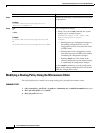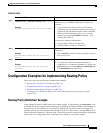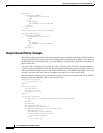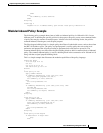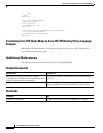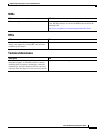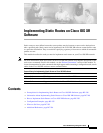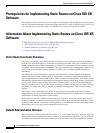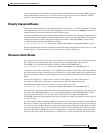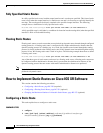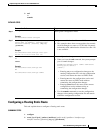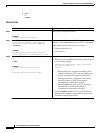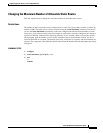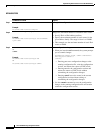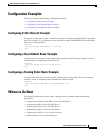
Implementing Static Routes on Cisco IOS XR Software
Prerequisites for Implementing Static Routes on Cisco IOS XR Software
RC-248
Cisco IOS XR Routing Configuration Guide
Prerequisites for Implementing Static Routes on Cisco IOS XR
Software
To use this command, you must be in a user group associated with a task group that includes the proper
task IDs. For detailed information about user groups and task IDs, see the Configuring AAA Services on
Cisco IOS XR Software module of the Cisco IOS XR System Security Configuration Guide.
Information About Implementing Static Routes on Cisco IOS XR
Software
To implement static routes you need to understand the following concepts:
• Static Route Functional Overview, page RC-248
• Default Administrative Distance, page RC-248
• Directly Connected Routes, page RC-249
Static Route Functional Overview
Static routes are entirely user configurable and can point to a next-hop interface, next-hop IP address, or
both. In Cisco IOS XR software, if an interface was specified, then the static route is installed in the
Routing Information Base (RIB) if the interface is reachable. If an interface was not specified, the route
is installed if the next-hop address is reachable. The only exception to this configuration is when a static
route is configured with the permanent attribute, in which case it is installed in RIB regardless of
reachability.
Networking devices forward packets using route information that is either manually configured or
dynamically learned using a routing protocol. Static routes are manually configured and define an
explicit path between two networking devices. Unlike a dynamic routing protocol, static routes are not
automatically updated and must be manually reconfigured if the network topology changes. The benefits
of using static routes include security and resource efficiency. Static routes use less bandwidth than
dynamic routing protocols, and no CPU cycles are used to calculate and communicate routes. The main
disadvantage to using static routes is the lack of automatic reconfiguration if the network topology
changes.
Static routes can be redistributed into dynamic routing protocols, but routes generated by dynamic
routing protocols cannot be redistributed into the static routing table. No algorithm exists to prevent the
configuration of routing loops that use static routes.
Static routes are useful for smaller networks with only one path to an outside network and to provide
security for a larger network for certain types of traffic or links to other networks that need more control.
In general, most networks use dynamic routing protocols to communicate between networking devices
but may have one or two static routes configured for special cases.
Default Administrative Distance
Static routes have a default administrative distance of 1. A low number indicates a preferred route. By
default, static routes are preferred to routes learned by routing protocols. Therefore, you can configure
an administrative distance with a static route if you want the static route to be overridden by dynamic



